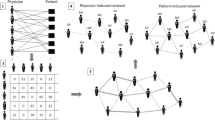Abstract
Background
There is a natural assumption that quality and efficiency are optimized when providers consistently work together and share patients. Diversity in composition and recurrence of groups that provide face-to-face care to the same patients has not previously been studied.
Objective
Claims data enable identification of the constellation of providers caring for a single patient. To indirectly measure teamwork and provider collaboration, we measure recurrence of provider constellations and cohesion among providers.
Design
Retrospective analysis of commercial healthcare claims from a single insurer.
Participants
Patients with claims for office visits and their outpatient providers. To maximize capture of provider panels, the cohort was drawn from the four regions with the highest plan coverage. Regional outpatient provider networks were constructed with providers as nodes and number of shared patients as links.
Main Measures
Measures of cohesion and stability of provider constellations derived from the networks of providers to quantify patient sharing.
Results
For 10,325 providers and their 521,145 patients, there were 2,641,933 collaborative provider pairs sharing at least one patient. Fifty-four percent only shared a single patient, and 19 % shared two. Of 15,449,835 unique collaborative triads, 92 % shared one patient, 5 % shared two, and 0.2 % shared ten or more. Patient constellations had a median of four providers. Any precise constellation recurred rarely—89 % with exactly two providers shared just one patient and only 4 % shared over two; 97 % of constellations with exactly three providers shared just one patient. Four percent of constellations with 2+ providers were not at all cohesive, sharing only the hub patient. In the remaining constellations, a median of 93 % of provider pairs shared at least one additional patient beyond the hub patient.
Conclusion
Stunning variability in the constellations of providers caring for patients may challenge underlying assumptions about the current state of teamwork in healthcare.


Similar content being viewed by others
References
Berwick D, Hackbarth A. Eliminating waste in US health care. JAMA: The Journal of the American Medical Association. 2012;307:1513–6.
Schroeder SA, Frist W. Phasing out fee-for-service payment. N Engl J Med 2013.
Berwick DM. Launching accountable care organizations–the proposed rule for the Medicare Shared Savings Program. N Engl J Med. 2011;364:e32.
Blumenthal DM, Song Z, Jena AB, Ferris TG. Guidance for structuring team-based incentives in healthcare. Am J Manag Care. 2013;19:e64–70.
About us. 2012. (Accessed June 17, 2014, at http://healthcore.com/home/research_enviro.php?page=Research.
Elliott AC, Hynan LS. A SAS((R)) macro implementation of a multiple comparison post hoc test for a Kruskal-Wallis analysis. Computer methods and programs in biomedicine. 2011;102:75–80.
Katzenbach J, Smith D. The Wisdom of Teams: Creating the High-performance Organization. New York: Harper Business; 2006.
Carter BL, Bosworth HB, Green BB. The hypertension team: the role of the pharmacist, nurse, and teamwork in hypertension therapy. J Clin Hypertens (Greenwich). 2012;14:51–65.
Grumbach K, Bodenheimer T. Can health care teams improve primary care practice? Jama. 2004;291:1246–51.
Manser T. Teamwork and patient safety in dynamic domains of healthcare: a review of the literature. Acta Anaesthesiol Scand. 2009;53:143–51.
Pollack CE, Weissman GE, Lemke KW, Hussey PS, Weiner JP. Patient sharing among physicians and costs of care: a network analytic approach to care coordination using claims data. J Gen Intern Med. 2013;28:459–65.
Landon BE, Keating NL, Barnett ML, et al. Variation in patient-sharing networks of physicians across the United States. JAMA: The Journal of the American Medical Association. 2012;308:265–73.
Landon BE, Onnela JP, Keating NL, et al. Using administrative data to identify naturally occurring networks of physicians. Med Care. 2013;51:715–21.
Pollack CE, Weissman G, Bekelman J, Liao K, Armstrong K. Physician social networks and variation in prostate cancer treatment in three cities. Health Serv Res. 2012;47:380–403.
Barnett ML, Landon BE, O’Malley AJ, Keating NL, Christakis NA. Mapping physician networks with self-reported and administrative data. Health Serv Res. 2011;46:1592–609.
Barnett ML, Christakis NA, O’Malley J, Onnela J-P, Keating NL, Landon BE. Physician patient-sharing networks and the cost and intensity of care in US hospitals. Med Care. 2012;50:152–60.
Pham HH, O’Malley AS, Bach PB, Saiontz-Martinez C, Schrag D. Primary care physicians' links to other physicians through Medicare patients: the scope of care coordination. Annals of internal medicine. 2009;150:236–42.
Acknowledgments
Supported by grant R21GM107645 from the National Institute of General Medical Sciences and G08LM009778 from the National Library of Medicine, NIH. We would like to thank Aurel Cami for his careful reading of and comments on the manuscript.
Conflict of interest
The authors declare that they do not have a conflict of interest.
Author information
Authors and Affiliations
Corresponding author
Electronic supplementary material
Below is the link to the electronic supplementary material.
ESM 1
(DOCX 19 kb)
Rights and permissions
About this article
Cite this article
Mandl, K.D., Olson, K.L., Mines, D. et al. Provider Collaboration: Cohesion, Constellations, and Shared Patients. J GEN INTERN MED 29, 1499–1505 (2014). https://doi.org/10.1007/s11606-014-2964-0
Received:
Revised:
Accepted:
Published:
Issue Date:
DOI: https://doi.org/10.1007/s11606-014-2964-0




